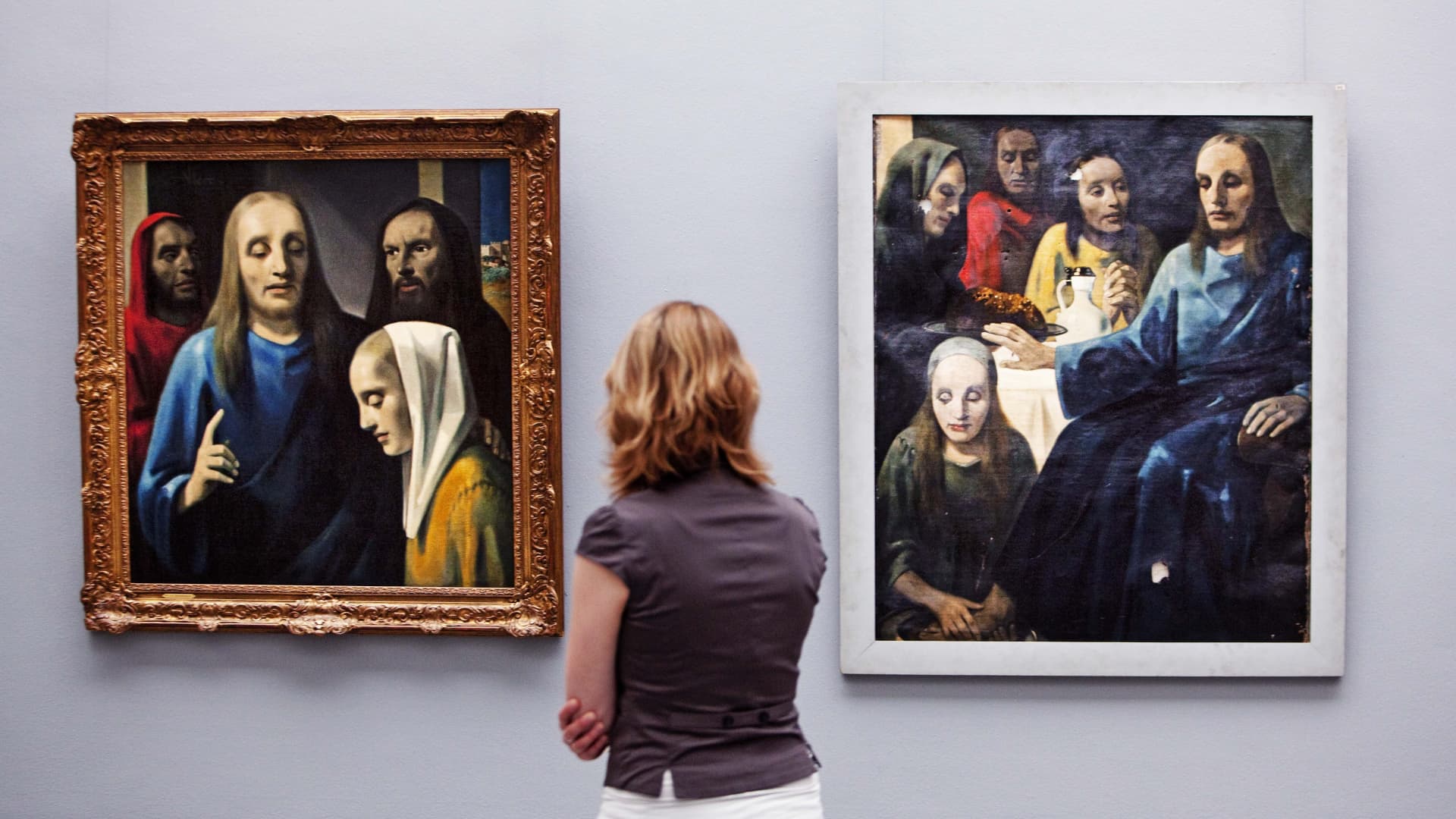Paintings by Han van Meegeren (1889-1947) at the Boijmans Van Beuningen Museum in Rotterdam on May 11, 2010. Van Meegeren became known for his forgeries, particularly of works by Dutch master Johannes Vermeer.
Robin Utrecht | AFP | Getty Images
Art forgeries are more common than you might think, but stories about them often stay underground.
That’s according to lawyer Helen Mulcahy, a partner at legal firm Fieldfisher who specializes in art and fraud.
“They often don’t come to light,” Mulcahy told CNBC by video call. “Reputation in the art market is so important … not many people like to go to court,” she said. Cases are often settled in private in part because of the “embarrassment factor” for a buyer.
Mulcahy advises wealthy clients on the checks they need to make when buying art, including attribution and provenance — namely, who has owned an artwork and when and where it has exchanged hands. Such information is detailed in exhibition records, auction catalog references, certificates or other documents.
“Provenance also should describe the medium, the dimensions, the date it was made. And sometimes it’s not always the artist, it might be attributed to the artist, it might be the school, the circle of, so there’ll be sort of levels down,” Mulcahy said. Checking provenance is relatively straightforward on the primary market, where collectors buy from a living artist’s studio or representative, but less so on the secondary market, which refers to the resale of works.
Buyer beware
Tom Rooth, an artist and dealer who spent more than a decade at high-end auction house Christie’s and left in 2017, said he sees fakes frequently. “I see them the whole time. You know, I can go onto an auction website now [and be able to] spot fakes … they are sort of everywhere,” he told CNBC by phone.
“[It was] a great training to work for an auction house because … you get emailed images, by people of their paintings, asking for valuations. You’re so used to seeing pictures on a screen and ascertaining whether they’re by the artist or not,” Rooth said.
He also spoke about having a sense that something is inauthentic, a sentiment shared by contemporary art dealer Jack Roberts. “Rather than assuming an artwork is legitimate, you have to be able to ‘prove’ its authenticity … When purchasing, anything that feels ‘not quite right,’ no matter how small, would stop me buying,” Roberts told CNBC by email.
“Where there [are] high value items involved (art/fashion/jewelry, etc.) there will be people out there trying to fraudulently make money,” Roberts said. And, if an artist was prolific and has a large market, “fakes will be more common,” he said.
Adam Szymanski, an art advisor and researcher based in Toronto, Canada, said there’s “a lot of due diligence” done by the art industry to authenticate work when undertaking transactions. “That said, there are a serious number of inauthentic works that circulate, particularly among deceased artists,” he told CNBC by phone.
In the case of native Canadian artist Norval Morrisseau — who has been called the “Picasso of the North” and died in 2007 — his forgers were prolific. Last year, more than 1,000 forged paintings were seized by police in Ontario after a long investigation that led to the arrest and sentencing of Gary Lamont, who oversaw their production. Criminal profits made by Lamont and others could be as much as $100 million, according to a report by the Smithsonian Magazine.
Canadian artist Norval Morrisseau in a 1977 photograph. In 2023, more than 1,000 forged Morrisseau paintings were seized by Toronto police.
Graham Bezant | Toronto Star | Getty Images
Szymanski said the scandal had “dampened” the market for Morrisseau’s art: his pieces regularly fetch around $40,000, but several works by “comparable” artist Jean-Paul Riopelle’s sold at auction for more than $1 million in November.
“There’s so much fear in the market, as you can imagine, because no one wants to purchase inauthentic work. People are confused,” Szymanski said.
‘Sensational stories’
Freya Sims, chief executive of industry body LAPADA, the Association of Art & Antiques Dealers, said she has seen forgeries in museums as well as in private collections, but for her, their prevalence is “less than you would think.”
“The stories that make it to print are either sensational stories or where big money has changed hands, but in reality, there is little point in investing time into forging something of relatively low value,” she told CNBC via email.
“Mistakes can be made when a generalist dealer sells something that is from a more rarified discipline,” she added. LAPADA, among other bodies, organizes fairs where work is vetted for authenticity, condition and correct labeling before it goes on display, Sims said.
Misattribution can also take place, Sims said. “The Massacre of the Innocents,” an early 17th-century painting by Peter Paul Rubens, had been wrongly catalogued in the 18th century and attributed to the lesser-known Jan van den Hoecke. Auction house Sotheby’s identified it as a Rubens, and it was sold in 2002 for $76.7 million — at the time the highest price ever for an Old Master painting at auction.
“The attributions of an artist can change over time, and this is not necessarily due to a forger — this could have been a specialist in the past evaluating something and giving it the wrong description,” Sims said.
